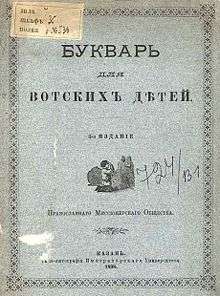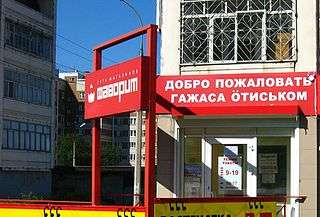Udmurt language
| Udmurt | |
|---|---|
| удмурт кыл udmurt kyl | |
| Native to | Russia |
| Region | Udmurtia |
| Ethnicity | Udmurts |
Native speakers | 340,000 (2010 census)[1] |
| Official status | |
Official language in | Udmurtia (Russia) |
| Language codes | |
| ISO 639-2 |
udm |
| ISO 639-3 |
udm |
| Glottolog |
udmu1245[2] |
Udmurt (удмурт кыл, udmurt kyl) is a Uralic language, part of the Permic subgroup, spoken by the Udmurt natives of the Russian constituent republic of Udmurtia, where it is co-official with Russian. It is written using a Cyrillic alphabet, including five characters not used in the Russian alphabet: Ӝ/ӝ, Ӟ/ӟ, Ӥ/ӥ, Ӧ/ӧ, and Ӵ/ӵ. Together with Komi and Komi-Permyak languages, it constitutes the Permic grouping. Among outsiders, it has traditionally been referred to by its Russian exonym, Votyak. Udmurt has borrowed vocabulary from the neighboring languages Tatar and Russian.
Ethnologue estimates 550,000 native speakers (77%) in an ethnic population of 750,000 in the former USSR (1989 census).[3]
Dialects
Udmurt varieties can be grouped in three broad dialect groups:
- Northern Udmurt, spoken along Cheptsa River
- Southern Udmurt
- Besermyan, spoken by the strongly Turkified Besermyans
A continuum of intermediate dialects between Northern and Southern Udmurt is found, and literary Udmurt includes features from both areas. Besermyan is more sharply distinguished.
The differences between the dialects are regardless not major, and mainly involve differences in vocabulary, largely attributable to the stronger influence of Tatar in the southern end of the Udmurt-speaking area. A few differences in morphology and phonology still exist as well, e.g.
- Southern Udmurt has an accusative ending -ыз /-ɨz/, contrasting with northern -ты /-tɨ/.
- Southwestern Udmurt distinguishes an eight vowel phoneme /ʉ/.
- Besermyan has /e/ in place of standard Udmurt /ə/ (thus distinguishing only six vowel phonemes), and /ɵ/ in place of standard Udmurt /ɨ/.
Alphabet
The Udmurt alphabet is based on the Russian Cyrillic alphabet:
| Uppercase | Lowercase | Transliteration[4] | IPA | Letter name |
|---|---|---|---|---|
| А | а | a | [ɑ] | а |
| Б | б | b | [b] | бэ |
| В | в | v | [v] | вэ |
| Г | г | g | [g] | гэ |
| Д | д | d | [d]; palatal [dʲ] when followed by я, е, и, ё, ю or ь | дэ |
| Е | е | e, ye | [je]; [ʲe] when preceded by д, т, з, с, л, or н | е |
| Ё | ё | yo | [jo]; [ʲo] when preceded by д, т, з, с, л, or н | ё |
| Ж | ж | zh | [ʒ] | жэ |
| Ӝ | ӝ | dzh | [dʒ] | ӝэ |
| З | з | z | [z]; palatal [ʑ] when followed by я, е, и, ё, ю or ь | зэ |
| Ӟ | ӟ | j | [dʲʑ] | ӟе |
| И | и | i | [i]; [ʲi] when preceded by д, т, з, с, л, or н | и |
| Ӥ | ӥ | ï | [i] | точкаен и, точкаосын и ("dotted i") |
| Й | й | y | [j] | вакчи и ("short i") |
| К | к | k | [k] | ка |
| Л | л | l | [ɫ]; palatal [lʲ] when followed by я, е, и, ё, ю or ь | эл |
| М | м | m | [m] | эм |
| Н | н | n | [n]; palatal [nʲ] when followed by я, е, и, ё, ю or ь | эн |
| О | о | o | [o] | о |
| Ӧ | ӧ | ö | [ʌ] ~ [ə] | ӧ |
| П | п | p | [p] | пэ |
| Р | р | r | [r] | эр |
| С | с | s | [s]; palatal [ɕ] when followed by я, е, и, ё, ю or ь | эс |
| Т | т | t | [t]; palatal [tʲ] when followed by я, е, и, ё, ю or ь | тэ |
| У | у | u | [u] | у |
| Ф1 | ф | f | [f] | эф |
| Х1 | х | kh | [x] | ха |
| Ц1 | ц | ts | [t͡s] | цэ |
| Ч | ч | ch | [t͡ɕ] | чэ |
| Ӵ | ӵ | tsh | [t͡ʃ] | ӵэ |
| Ш | ш | sh | [ʃ] | ша |
| Щ1 | щ | shch | [ɕ], [ɕː] | ща |
| Ъ2 | ъ | ” | – | чурыт пус ("hard sign") |
| Ы | ы | y | [ɨ] ~ [ɯ] | ы |
| Ь | ь | ’ | [ʲ] | небыт пус ("soft sign") |
| Э | э | e | [e] | э |
| Ю | ю | yu | [ju]; [ʲu] when preceded by д, т, з, с, л, or н | ю |
| Я | я | ya | [jɑ]; [ʲa] when preceded by д, т, з, с, л, or н | я |
- 1 Only used in Russian loanwords and names.
- 2 Silent, but required to distinguish palatalized consonants (/dʲ tʲ zʲ sʲ lʲ n/) from unpalatalized consonants followed by /j/ if followed by a vowel; for example, /zʲo/ and /zjo/ are written -зё- and -зъё-, respectively.
Phonology
The language does not distinguish between long and short vowels and does not have vowel harmony.
| Labial | Alveolar | Post- alveolar |
Alveolo- palatal |
Palatal | Velar | ||||
|---|---|---|---|---|---|---|---|---|---|
| plain | lat. | plain | lat. | ||||||
| Plosive | voiceless | p | t | k | |||||
| voiced | b | d | ɡ | ||||||
| Affricate | voiceless | (t͡s) | t͡ʃ | t͡ɕ | |||||
| voiced | (d͡z) | d͡ʒ | d͡ʑ | ||||||
| Fricative | voiceless | (f) | s | ʃ | ɕ | (x) | |||
| voiced | v | z | ʒ | ʑ | |||||
| Nasal | m | n | ɲ | ŋ | |||||
| Approximant | l | j | ʎ | ||||||
| Trill | r | ||||||||
The consonants /f x t͡s/ are restricted to loanwords, and are traditionally replaced by /p k t͡ɕ/ respectively.
| Front | Central | Back | ||
|---|---|---|---|---|
| Unrounded | Round | |||
| Close | i | ɨ | u | |
| Mid | e | ə | o | |
| Open | a | |||
Grammar

Udmurt is an agglutinating language. It uses affixes to express possession, to specify mode, time, and so on.
Lexicon
Depending on the style, about 10 to 30 percent of the Udmurt lexicon consists of loanwords. Many loanwords are from the Tatar language, which has also strongly influenced Udmurt phonology and syntax.

The Udmurt language itself, together with the Tatar language, influenced the language of the Udmurt Jews, in the dialects of which the words of Finno-Ugric and Turkic origin there were recorded.[5][6][7][8]
Media in Udmurt
Eurovision runners-up Buranovskiye Babushki, a pop group composed of Udmurt grandmothers, sing mostly in Udmurt.[9]
The romantic comedy film Berry-Strawberry, a joint Polish-Udmurt production, is in the Udmurt language.
In 2013, the film company "Inwis kinopottonni" produced a film in the Udmurt language called Puzkar ("nest").[10]
The Bible was first completely translated into Udmurt in 2013.[11]
Bibliography
- Kel'makov, Valentin; Sara Hännikäinen (2008). Udmurtin kielioppia ja harjoituksia (in Finnish) (2nd ed.). Helsinki: Suomalais-Ugrilainen Seura. ISBN 978-952-5150-34-6.
- Moreau, Jean-Luc (2009). Parlons Oudmourte. Paris: L'Harmattan. ISBN 2-296-07951-2.
References
- ↑ Udmurt at Ethnologue (18th ed., 2015)
- ↑ Hammarström, Harald; Forkel, Robert; Haspelmath, Martin; Bank, Sebastian, eds. (2016). "Udmurt". Glottolog 2.7. Jena: Max Planck Institute for the Science of Human History.
- ↑ Ethnologue code=UDM Archived October 9, 2008, at the Wayback Machine.
- ↑ "BGN/PCGN romanization of udmurt". Retrieved 24 March 2012.
- ↑ Altyntsev A.V., "The Concept of Love in Ashkenazim of Udmurtia and Tatarstan", Nauka Udmurtii. 2013. № 4 (66), p. 131-132. (Алтынцев А.В., "Чувство любви в понимании евреев-ашкенази Удмуртии и Татарстана". Наука Удмуртии. 2013. №4. С. 131-132: Комментарии.) (in Russian)
- ↑ Goldberg-Altyntsev A.V., "A short ethnographic overview of the Ashkenazic Jews' group in Alnashsky District of Udmurt Republic". Die Sammlung der wissenschaftlichen Arbeiten der jungen jüdischen Wissenschaftler. Herausgegeben von Artur Katz, Yumi Matsuda und Alexander Grinberg. München, Dachau, 2015. S. 51.
- ↑ Гольдберг-Алтынцев А.В., "Краткий этнографический обзор группы ашкеназских евреев в Алнашском районе Удмуртской Республики / пер. с англ. яз. А.Й. Каца." Jewish studies in the Udmurt Republic: Online. Part 1. Edited by A. Greenberg. February 27, 2015 published. P. 3. (in Russian)
- ↑ Goldberg-Altyntsev A.V., "Some characteristics of the Jews in Alnashsky District of Udmurt Republic." The youth. The creativity. The science. Edited by V. Cox, A. Katz and A. Greenberg. Trenton, 2014, p. 28. (גאלדבערג-אלטינצעוו א.ו., ". איניגע באזונדערהייטן פון די יידן אין אלנאשסקער רייאן פון ודמורטישע רעפובליק" The youth. The creativity. The science. = Die Jugend. Die Kreativität. Die Wissenschaft. = נוער. יצירתיות. מדע Edited by V. Cox, A. Katz and A. Greenberg. Trenton, 2014. P. 28.) (in Yiddish)
- ↑ Omelyanchuk, Olena (7 March 2012). "Buranovskiye Babushki to represent Russia in Baku". European Broadcasting Union. Retrieved 12 April 2015.
- ↑ "Пузкар (удмурт кино)".
- ↑ "First Bible in Udmurt – arrives this week!". United Bible Societies. Retrieved 12 April 2015.
External links
| Udmurt edition of Wikipedia, the free encyclopedia |
| Wikivoyage has a travel guide for Udmurt phrasebook. |
- Udmurtology: Udmurt Language, History and Culture(in Russian)
- Literature
- The First Udmurt Forum(in Russian)
- Udmurt State University (has Udmurt Language Program for English speakers)
- Udmurt language, alphabet and pronunciation
- Vladimir Napolskikh. Review of Eberhard Winkler, Udmurt, München 2001 (Languages of the World. Materials 212)
- Udmurt - Finnish/Komi Zyrian dictionary (robust finite-state, open-source)
- Learning Udmurt words